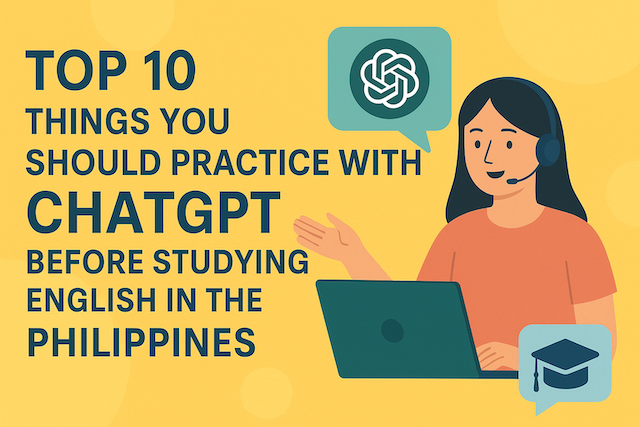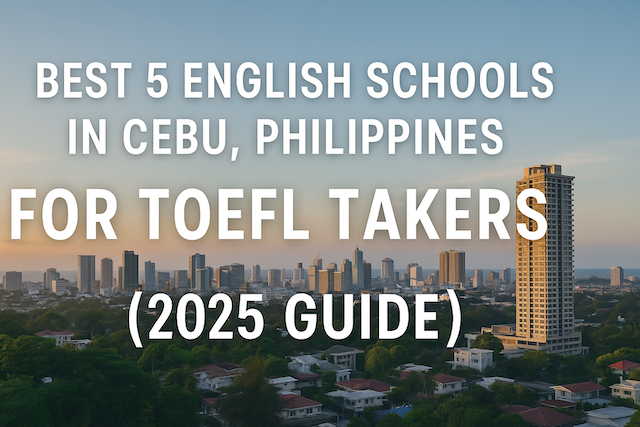Top 10 Things You Should Practice with ChatGPT Before Studying English in the Philippines
内容
- 1 🏷 Top 10 Things You Should Practice with ChatGPT Before Studying English in the Philippines
- 2 ✍️ はじめに
- 3 🧠 1. Practice Introducing Yourself
- 4 🎓 2. Simulate Your First Day at School
- 5 🕒 3. Talk About Your Daily Routine
- 6 🍽 4. Practice Ordering Food
- 7 🌍 5. Describe Your Country and Culture
- 8 💬 6. Practice Small Talk
- 9 📘 7. Review Basic Grammar
- 10 🧳 8. Learn Travel and Daily Life Vocabulary
- 11 🎧 9. Listening + Comprehension Practice
- 12 👩🏫 10. Simulate a 1-on-1 English Class
🏷 Top 10 Things You Should Practice with ChatGPT Before Studying English in the Philippines
✍️ はじめに
Studying English in the Philippines is one of the smartest choices for language learners. With affordable tuition, immersive English environments, and one-on-one lessons, it offers a perfect setup for rapid improvement. But did you know that you can already start preparing before you even leave your home country? And no—we’re not talking about buying expensive books or taking long online courses. All you need is ChatGPT.
Whether you’re a complete beginner or someone brushing up on your skills, ChatGPT can act as your personal practice partner 24/7. You can simulate real-life conversations, review essential grammar, expand your vocabulary, and even experience mock English lessons—all without any pressure or embarrassment.
Many students arrive in the Philippines and spend the first few weeks just getting used to speaking in English. But if you take time to warm up with ChatGPT, you’ll be ready to participate actively from day one. This article introduces 10 smart ways to use ChatGPT before your English study abroad journey begins. If you’re serious about making the most of your time in the Philippines, try these practical tips now and arrive with confidence.
🧠 1. Practice Introducing Yourself
🎯 Why This Matters
One of the very first things you’ll do when you arrive at your English school in the Philippines is introduce yourself. Whether you’re speaking to your teacher, your roommate, or your classmates, being able to clearly and confidently talk about who you are sets the tone for the rest of your experience.
A good self-introduction not only helps break the ice, but also gives others a positive first impression. If you fumble over basic things like your name, where you’re from, or why you’re studying English, it may make you feel frustrated or shy in your first week. On the other hand, if you’ve practiced these lines in advance, you’ll feel relaxed, confident, and ready to engage.
In most language schools in the Philippines, students are asked to introduce themselves on the first day—sometimes even in front of the class. Teachers may also ask questions like “Why did you choose to study in Cebu?”, “What are your goals?”, or “Have you studied English before?” If you prepare these answers ahead of time, you’ll be more comfortable and fluent when the moment comes.
🛠 How ChatGPT Can Help
ChatGPT can simulate a one-on-one teacher-student conversation where it acts as the teacher and asks you typical introductory questions. You can practice answering them aloud or in writing, and even ask ChatGPT to correct your grammar or suggest more natural phrases.
You can also expand your answers step by step. For example, start with a basic sentence:
“My name is Ken. I’m from Japan.”
Then ChatGPT might ask follow-up questions like:
“Which part of Japan are you from?”
“Why are you studying English?”
“How long will you stay in Cebu?”
Practicing in this interactive way helps you go beyond just memorized phrases—it helps you communicate.
💡 Example Prompts to Try
Here are some effective prompts you can copy and paste into ChatGPT:
-
“Pretend you are my English teacher. Please ask me 10 questions to help me practice my self-introduction.”
-
“Check my English after I introduce myself. Please suggest improvements.”
-
“Let’s role-play a first meeting between a student and teacher in Cebu. You start.”
📝 Optional Tips
-
Try recording yourself speaking your answers aloud for pronunciation practice.
-
Ask ChatGPT to give you feedback based on tone and clarity.
-
Practice different versions (formal/informal) depending on your audience.
-
Update your answers regularly as your plans or goals change.
🎓 2. Simulate Your First Day at School
🎯 Why This Matters
Your first day at an English school in the Philippines can be both exciting and nerve-wracking. You’ll be meeting your teachers for the first time, receiving your class schedule, taking placement tests, and possibly attending orientation sessions. All of this will likely be conducted in English.
For many students, the first day is full of “I didn’t catch that…” or “Sorry, can you repeat?” moments. But if you’re already used to hearing and responding to common school-related questions, you’ll be able to navigate that day smoothly. Preparing for typical conversations—like asking about classroom locations, break times, or how to access Wi-Fi—can dramatically reduce your anxiety.
Even if you’re not confident in your speaking skills yet, familiarity with the situation will make you feel in control. And when you’re in control, you’re more likely to enjoy your first day rather than just survive it.
🛠 How ChatGPT Can Help
With ChatGPT, you can simulate your entire first day before it even happens. You can ask ChatGPT to act as a school receptionist, a teacher, or a fellow student. You can walk through imaginary check-in procedures, placement test conversations, or basic FAQ sessions.
For example, ChatGPT might say:
“Welcome to 3D ACADEMY! Can I have your name, please?”
“Here is your class schedule. Do you have any questions about it?”
“Your placement test will start at 10:00 a.m. Don’t forget to bring a pen.”
This kind of role-play helps you mentally and linguistically prepare. You’ll already know what to expect—and how to respond appropriately.
💡 Example Prompts to Try
Try one or more of the following prompts with ChatGPT:
-
“Let’s role-play my first day at an English school in Cebu. You be the school staff, and I’ll be the student.”
-
“Act like a teacher doing a level check interview. Ask me basic English questions to place me in the right class.”
-
“Simulate an orientation session and explain the daily schedule, rules, and what I should bring to class.”
📝 Optional Tips
-
Request explanations if you don’t understand ChatGPT’s responses:
“Please explain that in simpler English.” -
Ask ChatGPT to quiz you afterward:
“Test my understanding of what just happened.” -
Try doing the same role-play multiple times with slightly different settings to increase your adaptability.
🕒 3. Talk About Your Daily Routine
🎯 Why This Matters
Talking about your daily routine is a common and practical topic in ESL (English as a Second Language) classes, especially at beginner and intermediate levels. It’s one of the first ways you’ll start using verbs, time expressions, and adverbs of frequency in real conversation.
In the Philippines, many schools use one-on-one lessons where teachers ask open-ended questions like:
“What time do you usually wake up?”
“What do you do after class?”
“Do you exercise every day?”
Being able to answer these fluently not only improves your grammar and vocabulary but also builds your confidence. Plus, your routine is something you know well—it’s the perfect low-pressure topic to get your English flowing.
If you arrive with this kind of speaking practice already done, you’ll be one step ahead. You won’t need to translate in your head. You’ll just speak.
🛠 How ChatGPT Can Help
ChatGPT is a fantastic partner for daily routine practice. You can ask it to interview you like a teacher would, help you build your answers step-by-step, or even correct your grammar and sentence structure.
For example, if you type:
“I wake up at 8am. I eat breakfast. I go to school.”
ChatGPT might suggest:
“Great! You could also say: ‘I usually wake up at 8 a.m., then I eat breakfast and head to school around 9.’”
You can also ask for new vocabulary (e.g., “brush my teeth,” “check social media,” “take a nap”) or sentence variations to sound more natural.
💡 Example Prompts to Try
Here are some helpful prompts to practice your routine:
-
“Ask me questions about my weekday routine, then help me improve my answers.”
-
“I want to describe my daily schedule from morning to night. Please guide me step by step.”
-
“Correct my grammar and suggest better ways to say these sentences: ‘I eat breakfast. I check phone. I go class.’”
📝 Optional Tips
-
Practice different types of days: weekdays vs weekends.
-
Ask ChatGPT to quiz you later:
“Ask me questions about the routine I just described.” -
Try recording yourself explaining your day in 60 seconds. Then improve it with ChatGPT’s help.
🍽 4. Practice Ordering Food
🎯 Why This Matters
Eating out is a big part of daily life during your stay in the Philippines. Whether you’re dining at your school’s cafeteria, a fast-food chain like Jollibee, or a local eatery down the street, you’ll need to interact with staff in English. Being able to order food clearly and politely will make you feel more independent—and reduce the chances of awkward misunderstandings.
For many students, the first time they speak English outside the classroom is when ordering lunch or dinner. It might seem simple, but in reality, it involves several steps:
-
Reading and understanding the menu
-
Asking about dishes or ingredients
-
Making special requests
-
Responding to follow-up questions like “For here or to go?”
If you’ve never practiced this kind of conversation, it can catch you off guard. But if you’ve rehearsed these situations with ChatGPT, you’ll be ready to handle them with confidence and ease.
🛠 How ChatGPT Can Help
ChatGPT can simulate the exact experience of ordering food at a restaurant or food court. You can ask it to act as a waiter or cashier and go through the entire process—from greeting to payment.
例えば、こうだ:
ChatGPT: “Good afternoon! Welcome to Cebu Lechon House. Are you ready to order?”
You: “Yes, I’d like one serving of lechon with rice, please.”
ChatGPT: “Would you like any drinks with that?”
You: “Yes, a bottle of water.”
ChatGPT: “For here or to go?”
This kind of interactive practice helps you get used to both expected questions and natural expressions. You can also ask ChatGPT to introduce local Filipino dishes so you’re not surprised when you see unfamiliar menu items.
💡 Example Prompts to Try
Try using these prompts in ChatGPT to simulate ordering food:
-
“Pretend you’re a waiter at a Filipino restaurant. Let me order food and help me respond politely.”
-
“I want to practice asking about the menu. Ask me questions and correct my English if needed.”
-
“Explain how to order food at a fast-food restaurant in Cebu. Then let’s role-play the conversation.”
📝 Optional Tips
-
Ask ChatGPT to explain common food-related vocabulary (e.g., “grilled,” “spicy,” “combo meal”).
-
Practice making special requests:
“Can I have it without onions?” / “Is this dish spicy?” -
Learn phrases for paying:
“Can I pay by card?” / “How much is it?” / “Keep the change.”
🌍 5. Describe Your Country and Culture
🎯 Why This Matters
When studying abroad—especially in a multicultural environment like the Philippines—you’ll often be asked about your home country. Teachers, classmates, and even locals are usually curious about your culture, traditions, food, holidays, and way of life. These conversations aren’t just small talk—they’re valuable opportunities to practice real English while sharing something meaningful about yourself.
Describing your country and culture helps you:
-
Practice key vocabulary (geography, food, festivals, lifestyle)
-
Learn how to structure longer, more detailed answers
-
Build confidence speaking about familiar topics
-
Connect with others through cultural exchange
In one-on-one classes, teachers might say things like:
“Tell me about your hometown.”
“What do people usually eat in your country?”
“How do you celebrate the New Year?”
If you’ve never explained these things in English before, it can be hard to find the right words. That’s where ChatGPT comes in.
🛠 How ChatGPT Can Help
With ChatGPT, you can rehearse these conversations as often as you like. You can ask it to interview you about your country, correct your grammar, and suggest more natural phrasing. You can even dive deeper into specific topics, like food, education, or social customs.
Example exchange:
ChatGPT: “Tell me about a traditional festival in your country.”
You: “We have a summer festival called Obon. People dance, eat special food, and visit family graves.”
ChatGPT: “That’s interesting! What kind of food do people eat during Obon?”
You: “Grilled corn, shaved ice, and fried noodles.”
ChatGPT: “Do you wear traditional clothes during the festival?”
This kind of back-and-forth practice builds your ability to express complex ideas clearly and confidently.
💡 Example Prompts to Try
Try these prompts with ChatGPT to describe your background:
-
“Ask me 10 questions about my home country’s culture and traditions.”
-
“Let’s role-play a conversation where I talk about my country’s holidays and food.”
-
“Help me explain my country’s education system in simple English.”
📝 Optional Tips
-
Focus on topics likely to come up in class: food, holidays, school, work culture.
-
Ask ChatGPT to help translate words you don’t know.
-
Practice turning short answers into longer explanations.
“We eat sushi.” → “Sushi is a traditional Japanese food made with rice and raw fish. It’s very popular, especially at celebrations.”
💬 6. Practice Small Talk
🎯 Why This Matters
Small talk is one of the most important—and most underrated—skills when studying abroad. While grammar drills and textbook exercises are useful, it’s casual conversation that builds real-world fluency. In the Philippines, where English schools often have friendly, community-like atmospheres, small talk happens everywhere: in the dormitory, in the cafeteria, in the elevator, or between classes.
Simple questions like:
“How was your weekend?”
“Did you already eat?”
“Where are you going later?”
…might seem easy, but they require quick thinking, listening skills, and the ability to respond naturally. The better you get at small talk, the more social connections you’ll build—and the more comfortable you’ll feel in your new environment.
If you’re shy or unsure how to start or continue a casual conversation, ChatGPT is the perfect tool to practice safely and comfortably.
🛠 How ChatGPT Can Help
ChatGPT can simulate informal conversations in countless everyday scenarios. You can ask it to act like a classmate, a roommate, or a fellow traveler. It can start a friendly chat, help you reply, and even give you feedback to improve your flow and fluency.
Example exchange:
ChatGPT: “Hey! How’s your day going?”
You: “Pretty good! I just finished class.”
ChatGPT: “Nice. What class did you have today?”
You: “Grammar and listening. It was fun.”
ChatGPT: “Cool. Any plans after class?”
These low-pressure interactions help you learn how to:
-
Keep the conversation going
-
Respond with natural expressions
-
Show interest with follow-up questions
-
Use appropriate tone (friendly, casual)
You can also ask ChatGPT to give you conversation starters or review your responses for fluency.
💡 Example Prompts to Try
Try these small talk exercises with ChatGPT:
-
“Pretend you’re my classmate at an English school. Start a casual conversation with me.”
-
“Let’s practice small talk at the dorm. You ask the first question.”
-
“Correct my responses and suggest more natural replies in casual English.”
📝 Optional Tips
-
Practice both starting and replying to conversations.
-
Learn natural filler expressions like:
“Oh really?” / “That sounds cool!” / “I see.” -
Use emojis or voice features (if available) to get used to emotional tone.
-
Challenge yourself to keep the conversation going for 10 turns or more.
📘 7. Review Basic Grammar
🎯 Why This Matters
Grammar might not be the most exciting part of language learning—but it’s the foundation. Without a solid understanding of basic grammar, you’ll struggle to form correct sentences, understand instructions in class, or express your thoughts clearly.
In most ESL schools in the Philippines, grammar is reviewed through structured lessons and conversation practice. Teachers may use questions like:
“Can you tell me the difference between ‘I go’ and ‘I am going’?”
“Why did you say ‘he have’ instead of ‘he has’?”
If you’re not prepared, it’s easy to feel embarrassed or fall behind. But reviewing common grammar points 以前 you arrive can help you hit the ground running.
🛠 How ChatGPT Can Help
ChatGPT can act as a personal grammar tutor, available 24/7. You can use it to:
-
Explain grammar rules in simple English
-
Give examples and comparisons
-
Create custom quizzes and correct your answers
-
Help you practice using target grammar points in full sentences
Let’s say you want to review the present simple vs present continuous. You can ask:
“What’s the difference between ‘I eat lunch’ and ‘I am eating lunch’?”
ChatGPT might reply:
“‘I eat lunch’ = your habit or routine.
‘I am eating lunch’ = what you’re doing right now.”
You can then ask it to give you example sentences, ask you quiz questions, or help you write your own sentences with feedback.
💡 Example Prompts to Try
Here are some smart ways to review grammar with ChatGPT:
-
“Teach me the present simple and present continuous with 5 examples and a quiz.”
-
“I always confuse ‘much’ and ‘many.’ Please explain the rule and give me a practice test.”
-
“Correct these sentences and explain the grammar: ‘She go to school every day.’ / ‘He don’t like coffee.’”
📝 Optional Tips
-
Focus on common beginner/intermediate grammar points:
– Tenses (present, past, future)
– Articles (a, an, the)
– Subject-verb agreement
– Prepositions -
Use your own writing as practice material. Ask ChatGPT:
“Check my paragraph and tell me if there are any grammar mistakes.” -
Review grammar in small sessions (10–15 minutes a day) instead of cramming.
🧳 8. Learn Travel and Daily Life Vocabulary
🎯 Why This Matters
Even if your grammar is solid, it’s hard to communicate without the right words. During your stay in the Philippines, you’ll need to talk about travel plans, shopping, weather, schedules, and everyday tasks. Knowing practical, high-frequency vocabulary will help you feel more confident and independent in real-life situations.
Examples of daily vocabulary you’ll often hear or use:
“How much is this?”
“Where is the nearest ATM?”
“I need to buy toothpaste.”
“Let’s meet at the lobby at 8 a.m.”
Many students rely too heavily on classroom vocabulary and freeze when dealing with real-world English. That’s why it’s a great idea to build a strong daily vocabulary base before your trip—even just 10–15 words per day can make a big difference.
🛠 How ChatGPT Can Help
ChatGPT can teach you topic-based vocabulary in a personalized, interactive way. You can ask it to list words by theme, create example sentences, quiz you, or even build short dialogues to show how the vocabulary is used in context.
例えば、こうだ:
“Teach me 10 words related to shopping, with example sentences.”
ChatGPT might reply:
-
価格 – “What is the price of this T-shirt?”
-
Receipt – “Don’t forget to ask for a receipt.”
-
Try on – “Can I try this on?”
…and so on.
You can also request fill-in-the-blank exercises, sentence rearrangement quizzes, or ask it to test you after every set.
💡 Example Prompts to Try
Use these prompts to supercharge your vocabulary with ChatGPT:
-
“Teach me 10 useful English words for everyday life in the Philippines. Include definitions and sample sentences.”
-
“Give me a vocabulary quiz on travel and transportation. Use multiple choice format.”
-
“Create a short dialogue between two students using daily life vocabulary. Then ask me questions about it.”
📝 Optional Tips
-
Study by theme: travel, shopping, directions, food, emergencies, health.
-
Ask ChatGPT to repeat or rephrase if you don’t understand.
-
Use new words in your own sentences and ask ChatGPT to check them.
-
Try this challenge: “Give me 5 words a day and test me at the end of the week.”
🎧 9. Listening + Comprehension Practice
🎯 Why This Matters
Listening is one of the most difficult skills for English learners—and one of the most important when studying abroad. In the Philippines, English teachers speak at a natural speed, and you’ll also hear a mix of accents from American movies, local Filipino English, and even fellow international students. If your ears aren’t used to it, you may find yourself saying “Sorry?” or “Can you repeat that?” more often than you’d like.
Whether it’s following classroom instructions, watching a video in class, or chatting with classmates, your listening skills affect your overall success. The good news? You can start improving your listening skills before you even arrive—by combining ChatGPT with other tools.
🛠 How ChatGPT Can Help
While ChatGPT doesn’t speak (unless paired with a voice tool like TTS), it can help you simulate listening practice in several creative ways. For example:
-
It can provide short stories, dialogues, or news summaries for you to read aloud または listen to using TTS (Text-to-Speech) tools.
-
It can give you comprehension questions after a story to test your understanding.
-
It can generate fill-in-the-blank listening quizzes if you copy the text into a TTS tool.
You can also combine ChatGPT with free tools like Google Translate’s audio or browser extensions like “Read Aloud” to turn text into speech. Then ask ChatGPT to quiz you on what you heard.
Sample practice:
ChatGPT: “Here’s a short story: A student named Anna arrived in Cebu to study English. On her first day, she…”
Then:
“Here are 3 questions:
Why did Anna come to Cebu?
What happened on her first day?
How did she feel?”
This makes your listening practice active, not passive.
💡 Example Prompts to Try
Use these ChatGPT prompts to train your ears and mind:
-
“Give me a short English story for listening practice, and ask me 5 comprehension questions.”
-
“Create a short dialogue between a student and a teacher. Then quiz me on it.”
-
“Make a listening quiz about checking into a hotel. Include audio-compatible text and questions.”
📝 Optional Tips
-
Use browser tools to read ChatGPT’s text aloud.
-
Try shadowing: repeat sentences out loud right after hearing them.
-
Ask ChatGPT to highlight key phrases or difficult vocabulary.
-
Combine reading + listening: read along as you listen to increase comprehension.
👩🏫 10. Simulate a 1-on-1 English Class
🎯 Why This Matters
One of the biggest advantages of studying English in the Philippines is the 1-on-1 lesson format. Unlike traditional classroom settings, these private sessions allow you to speak more, receive personalized feedback, and improve at your own pace. But for first-time students, it can also be a little intimidating—especially if you’re not used to speaking English for 30–50 minutes straight with just one teacher.
During these lessons, teachers will expect you to:
-
Answer open-ended questions
-
Give your opinions
-
Ask questions when confused
-
Engage in natural conversation
If you’ve never experienced a one-on-one lesson, your first class may feel overwhelming. But if you simulate it in advance with ChatGPT, you’ll already know the rhythm, expectations, and flow of this powerful learning style.
🛠 How ChatGPT Can Help
ChatGPT can role-play as your personal ESL teacher. You can practice full-length lessons on any topic, receive gentle corrections, and even get grammar explanations when you’re stuck. The best part? You can pause, repeat, or ask for help without feeling embarrassed.
Sample session:
ChatGPT: “Hi there! Welcome to your first 1-on-1 class. Let’s start by talking about your hobbies. What do you like to do in your free time?”
You: “I like watching anime and listening music.”
ChatGPT: “Great! Just a small correction: say ‘listening への music.’ Can you tell me more about your favorite kind of music?”
This style mimics the real experience: guided questions, natural feedback, and supportive correction.
You can also ask ChatGPT to adjust its role:
-
Speak like a beginner-friendly teacher
-
Pretend to give a vocabulary-focused lesson
-
Guide a discussion class on current events or travel
💡 Example Prompts to Try
Use these prompts to simulate real ESL classes:
-
“Pretend to be my English teacher in a one-on-one class. Guide a 15-minute lesson and correct my mistakes.”
-
“Give me a speaking task about travel, then ask follow-up questions.”
-
“Explain new vocabulary during our lesson, just like a real ESL teacher would.”
📝 Optional Tips
-
Ask for corrections in a specific way:
“Only correct grammar.” / “Correct me politely after each answer.” -
Try combining grammar + speaking by asking:
“Give me a mini-lesson on past tense, then ask me 5 questions using it.” -
Record your ChatGPT sessions (text or voice) and review them later.
-
Use this practice regularly to build stamina for 1-on-1 conversations.







